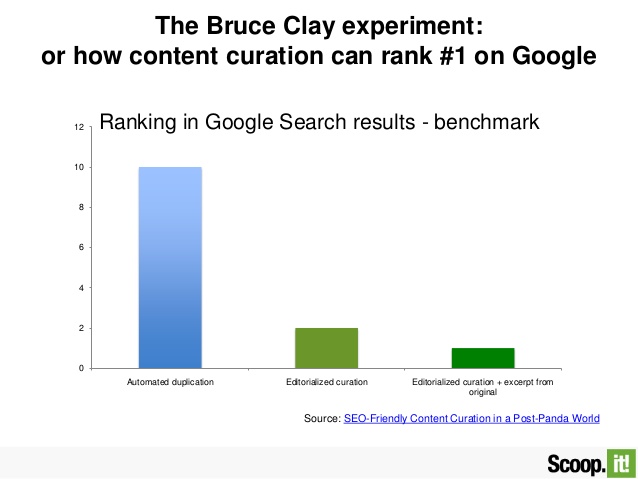
In a digital world where semantic optimization (SEO) and social marketing slowly dominate how businesses can connect with their targeted audiences, content marketing emerged as a key digital marketing tool that will bring in the profitable results you need. Up to 87% of digital marketers consider content marketing as more important than events, SEO, and other tactics. They believe in this as much that 71% of these marketers are increasing their allocated marketing budget and channeling it to content marketing.
However, content marketing do involve substantial costs, particularly in the production of new content, whatever its form may be. The table bloew shows how much it would cost to produce particular types of content and how long it would take them.

If the business owner has limited resources, he or she may not be able to sustain production on a continuous and regular basis. You might even find yourself burning out from your content marketing campaign. What you need is to boost your content resources through content curation.
But what is content curation? Is it using other peoples content on your own blog or website? Isn’t those kinds of practices what Google don’t like, putting you in danger of being penalized for it? If performed properly, content curation is actually a good (and legal) practice that the search engines’ support. It all boils down to searching and choosing the best content you can find, add value to it through original content – summaries, commentaries, editorials and reviews – and publishing it anew. It is not posting duplicated content, contrary to what others may think, as you can see from the comparison table below.

Content curation is also a great practice that will help build good SEO for you, as what 65% of 1,550 professionals in the US agree to in a recent survey. On top of that, up to 76% of these individuals reported getting good results on their business goals when they used content creation. This was confirmed by an experiment conducted by Bruce Clay that showed better performance in terms of ranking in Google search results when they used a combination of curated and original content.

Now that you’re familiarized with the benefits and impact content curation can do for your digital marketing efforts, it’s high time that you get up to speed with the following key tactics. These will show you how to leverage on content curation to boost your content marketing efforts – and get the results your want.
1. Original Content is Still King
You may wonder (and may have already grown tired of reading about it) why the cliché “Content is King” is still referred to in this article about content curation. As described earlier, content curation is not about publishing duplicated or copy/pasted content from some poor old chap’s website and claim it as your own. Content curation is all about giving value to your readers by sharing to them something you found in the internet, produced by someone else, that you think might interest or be relevant to them.
And how do you facilitate giving that value when you curate materials from other sources? You do that by adding original editorialized content to the curated article or story. A good rule of thumb for creating editorialized content is produce content equal to or greater in length to the curated content, or produce a minimum of 200 words per story that are unique and original.
2. Use Quoting instead of Summarizing or Abstracting
There are many ways on how to curate content from other sources. Those who are new and not yet fully familiarized with this method usually think curation is merely getting an excerpt – not the whole source article – and posting the content together with its title as well as images (if they are available). This is called Abstracting and is basically still copy-pasting not-so-original content. This might put you in danger of getting penalized by Google or even copyright infringement complaints. On top of that, abstracting also has little or no impact on SEO.
Another method used by digital marketers is Summarizing. This entails writing a short summary of the original article in your own words, which require more effort on your part than merely getting excerpts or an abstract. However, this may give little value for your readers, as they can always go directly to the link and read the original article themselves.
What you need to do is to use Quoting instead, where you put your selected excerpts from the original article and put in quotes. You then create your original editorialized content that will prove more valuable for your targeted audiences, as well as getting higher SEO value for your content because of the original materials you placed into it. The following is an example:
Commentary on Why Jeff Bezos Bought The Washington Post:
Soon after Red Sox owner John Henry bought the Boston Globe, Amazon CEO Jeff Bezos bought the Washington Post, leaving media insiders to wonder how these two business moguls might revitalize the print newspaper business.
“…It’s likely he’ll bring some Amazon management techniques to the Post (get ready for those six-page documents) and encourage experimentation without regard for short-term profits and losses. Bezos abhors anything that inconveniences his customers, so the paywall that washingtonpost.com instituted this spring might crumble. And if any of these moves undermine the Post’s teetering revenue sources, such as print ad pages, Bezos probably won’t care much … His overarching goal will be to create a thriving new media species on the digital frontier.”
Bezos has made Amazon hugely successful, but then he built Amazon from the ground up, while the Washington Post is an established brand in a struggling industry. Will his innovative approach to business and his deep pockets turn things around for the paper? Only time will tell.
When Quoting, make sure that you select only the best and relevant pieces of content from your original source article. It would be best to use only short quotes that will create the best impact on your audience. Avoid using multiple quotes from your source materials as you might then get penalized for copyright infringement or going beyond what can still be classified as Fair Usage. Again the length of your editorialized content should be longer than your quotes.
3. Get and Link Only Sources that are of High Quality
This might sound obvious but it is still very important to emphasize that you should select content to curate only from high quality sources that are relevant, interesting and enough to get the attention of your targeted audiences. A good selection checklist can be found below that will help you in the selection process of your curated content.
- Topic – Choose a topic that will not only relate to your brand or niche, but also something that is interesting enough for your targeted audiences to care about.
- Source – You should not select sources for your curated content just from anywhere or any website. Choose a source that is known and trusted by you, your targeted audiences and their existing readership as well.
- Readability – You should also select content that is easy to read and understand as well as being preferably close to your own style of writing.
Don’t forget one most important thing – properly cite or credit your sources as well as link to the original article. This is a good and ethical practice that is widely acceptable. You should also avoid using the ‘nofollow’ links as you will rob your source content creators with SEO credits generated by your campaign. Creating goodwill with other content providers is important and you can achieve this through your links.
4. Make Use of Embeddable Media
Content curation is not just for text content but also for visual media. The use of pictures, graphics and video will create better engagement with targeted audiences, higher than what other media types can generate. Sources abound in the Internet where you can get embeddable media and you can immediately refer to the list provided below:
- YouTube
- Slideshare
- Google+
- Vine
- Branch
- List.ly
When curating content using 3rd party embeddable media, it would be best to include a static image with your post together with your curated content.
5. Add Value through Story-telling, Perspectives and Commentaries
Curating content is adding value to your external source through original text. But it should not be just any other text, but rather embed it with your own perspectives or commentaries in reflection or reaction to the curated content. You can even expound on it more by telling a story that is relevant to your source content that your targeted audiences will find interesting.
6. Weave Multiple Pieces of Content Together
You can use text and you can use graphics – so why not weave various types of content and form a new tapestry of curated content that your targeted audiences will find fascinating. You can use a combination of text, graphics and embed some video or audio clips. You can also spice it up a little by throwing in some interesting tweets. You can also round up small excerpts from various blog posts, each of which you can enhance with other interesting information that include your views and commentaries.
7. Make Use of Proven Tools to Help You with Content Curation
While you can always do content creation manually, you can always make use of proven tools that will help you in the curation process. Some of these tools are free while some are paid channels. Through these tools, you can easily track, identify and stitch content from various sources that will help you in your content marketing campaign. These tools include but are not limited to the following:
- Storify
- Scoop.it
- Paper.li
- Bundlepost
- List.ly
- Curata
- Magnify.net
- Swayy.co
- Uberflip.com
- Topsy
- Alltop
- Feedly
- Tweetdeck
Content marketing is an important and yet resources-consuming tool that you can use for your digital marketing strategies. However, unless you have full resources at your disposal, it will be very difficult to sustain content creation and marketing activities without getting help from other sources – and you can effectively tap these resources through Content Curation.
Jomer B. Gregorio is a well-rounded expert when it comes digital marketing. Jomer is also known as a semantic SEO evangelist and practitioner. Check out our Digital Marketing Services today and let us help you in achieving positive and profitable results for your business.
